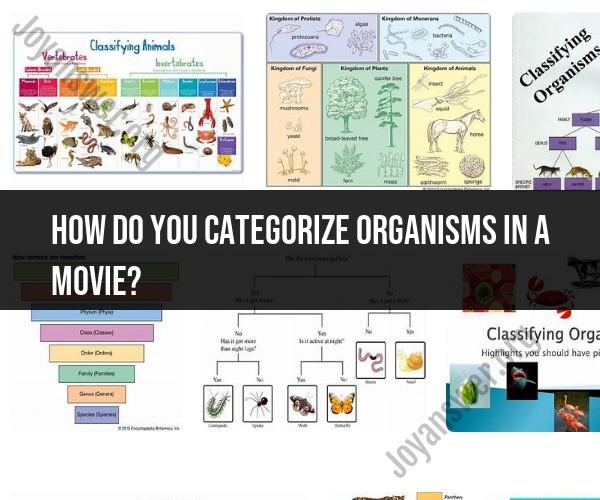How do you categorize organisms in a movie?
Categorizing organisms in a movie, especially in the context of filmmaking and storytelling, typically involves classifying them based on their roles and importance to the narrative. This categorization isn't scientific or taxonomic like the biological classification system, but rather a storytelling approach. Here are some ways organisms (characters or creatures) in a movie can be categorized:
Protagonists: These are the main characters of the story, often the heroes or central figures that the audience follows throughout the movie. Protagonists are typically human or humanoid characters, but they can also be animals or creatures with anthropomorphic traits.
Antagonists: Antagonists are the primary adversaries or opponents of the protagonists. They provide conflict and opposition to the main characters and drive the central conflict of the story.
Supporting Characters: These characters play important roles in the story but are not the central focus. They may have subplots or contribute to the development of the main characters.
Sidekicks: Sidekicks are characters who accompany and assist the protagonists. They often provide comic relief, moral support, or specialized skills that help the main characters achieve their goals.
Extras: Extras are characters with minimal or no speaking roles who appear in the background to create a realistic or immersive environment. They don't significantly impact the plot.
Animals and Creatures: Movies often feature animals or fantastical creatures. These organisms can serve various purposes in the story, from companions to sources of danger or mystery.
Symbolic or Metaphorical Characters: In some movies, characters may represent abstract concepts or ideas rather than being literal organisms. They are used symbolically to convey deeper themes or messages.
Extrasensory or Supernatural Entities: In science fiction, fantasy, or horror movies, organisms with supernatural or extraordinary abilities may be included. These beings can defy the laws of nature and contribute to the story's speculative elements.
Voiceless Characters: Some organisms in animated films or movies with non-human characters may not speak but communicate through other means, such as body language or expressions.
Background Creatures: In movies with elaborate fictional worlds, there may be a variety of background creatures and organisms that populate the environment, adding richness to the setting.
Cameo Appearances: Occasionally, real-life organisms, celebrities, or characters from other movies may make cameo appearances in a film for comedic or referential purposes.
The categorization of organisms in a movie is a fundamental aspect of storytelling and character development. Filmmakers carefully select and craft these characters to create a compelling narrative, evoke emotions, and convey messages or themes to the audience. The way these organisms are categorized and their roles contribute to the overall impact and enjoyment of the film.
Organism classification in film is a fascinating topic that can be used to create a variety of different effects. By understanding how to classify organisms, filmmakers can create more realistic and believable worlds, as well as convey different themes and messages to their audience.
There are a number of different ways to classify organisms in film. One common approach is to use the traditional taxonomic system, which divides organisms into kingdoms, phyla, classes, orders, families, genera, and species. This system can be used to create a hierarchy of organisms, with more complex organisms at the top and less complex organisms at the bottom.
Another approach to classifying organisms in film is to use ecological categories. This approach groups organisms based on their role in the environment, such as producers, consumers, and decomposers. Ecological categories can be used to create a more dynamic and realistic view of the natural world.
Filmmakers can also use their own unique criteria to classify organisms in film. For example, a filmmaker might classify organisms based on their size, color, or behavior. This can be used to create more creative and imaginative worlds, as well as to convey specific messages to the audience.
Here are some examples of how organism classification has been used in film:
- In the film Jurassic Park, the filmmakers used the traditional taxonomic system to create a believable world of dinosaurs. The dinosaurs were classified into different species based on their physical characteristics and behavior.
- In the film Avatar, the filmmakers used ecological categories to create a dynamic and realistic view of the planet Pandora. The Na'vi people were classified as consumers, while the Tree of Souls was classified as a producer.
- In the film Spirited Away, the filmmakers used their own unique criteria to classify the spirits of the bathhouse. The spirits were classified based on their physical appearance and behavior.
Overall, organism classification in film is a powerful tool that can be used to create a variety of different effects. By understanding how to classify organisms, filmmakers can create more realistic and believable worlds, as well as convey different themes and messages to their audience.
In addition to the examples above, here are some other ways that organism classification can be used in film:
- To create a sense of wonder and amazement. When audiences see a variety of different and exotic organisms in a film, it can help to create a sense of wonder and amazement.
- To convey the fragility of the natural world. By showing how different organisms are interconnected and how they depend on each other for survival, films can help to convey the fragility of the natural world.
- To explore themes of identity and belonging. By showing how different organisms are classified and how they fit into the natural world, films can help to explore themes of identity and belonging.
Ultimately, the way that organism classification is used in film is up to the filmmaker. However, by understanding the different ways that organisms can be classified, filmmakers can create more creative and meaningful films.













